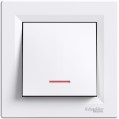—
Normal (non-passable). Non-passing switches use the simplest connection scheme. Several wires (phase and zero) are connected to each button, and their functionality is limited to power supply and power off. Conventional switches may have one, two, three or more buttons. Additionally, when choosing electrical accessories, you should pay attention to the type of construction — non-passable switches can be designed for built-in or surface mounting.
—
Checkpoint. Pass-through switches use a complex wiring diagram. The phase wire is divided into two or more branches, providing simultaneous connection to two or more switches. The pass-through type connection allows you to turn on and off the lighting or any other current consumer from several (two or more) switches. Such a connection is indispensable in large rooms or long corridors. To turn off the lighting, there is no need to return to the switch at the other end of the room, because you can turn off the light from another switch, which is located at the exit.
—
Cross. Cross-type switches are used to turn on / off the lighting system (or other current consumer) from different places. When installing two or more cross switches, any of them can turn on / off the light. This can be very useful when controlling lighting in a large room — in this case, cross switches are mounted in different parts of the obj
...ect. Also, models of this type are used as intermediate ones, installed between the switches. As independent cross switches are not used.
